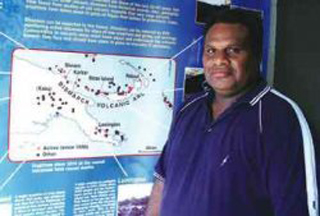Report on Obituary Notices (Unknown) — July 2012
Bulletin of the Global Volcanism Network, vol. 37, no. 7 (July 2012)
Managing Editor: Richard Wunderman.
Obituary Notices (Unknown) Death of volcanologist Herman Patia Principal Volcanologist at the Rabaul Volcano Observatory
Please cite this report as:
Global Volcanism Program, 2012. Report on Obituary Notices (Unknown) (Wunderman, R., ed.). Bulletin of the Global Volcanism Network, 37:7. Smithsonian Institution. https://doi.org/10.5479/si.GVP.BGVN201207-600400
Obituary Notices
Unknown
Lat Unknown, Unknown; summit elev. m
All times are local (unless otherwise noted)
One of the first homegrown volcanologists in Papua New Guinea (PNG), Herman Patia (figure 1), grew up the youngest of nine children in Gunanba, a village at the Eastern end of New Britain Island and S of Rabaul caldera. He died on 18 June 2012, two days short of his 50th birthday, in Rabaul Town after a month of unstated illness (Itikarai, 2012, which this obituary summarizes). Patia completed all his early schooling through his BS degree in PNG. He completed an MS degree at the Australian National University with a thesis on Rabaul’s petrology and geochemistry (Patia, 2004). He continued to write papers, including co-authorship on the workshop report cited below (Johnson and others, 2010).
 |
Figure 1. Herman Patia standing before a poster on Papua New Guinea volcanism. Courtesy of Keith-Reid (2007). |
Patia began work at Rabaul Volcano Observatory (RVO) in 1986 and rose to the position of Principal Volcanologist. RVO monitors the country’s 57 known Holocene volcanoes, some of which are quite active and close to settlements. Like many scientists working at volcano observatories, Patia’s contributions were multifaceted, spanning from research and publishing to volcano monitoring, and from mapping and hazards assessment to raising community awareness. PNG volcanoes draw international interest, and visitors recall benefitting from Herman’s advice and assistance. He was widely known as someone with both technical competence as well as an amiable, good-natured disposition.
More than once, duty dictated an immediate response to a sudden crisis, putting Patia in situations that could entail considerable risk. For example, in responding to a crisis at Langila in the early 1990’s, he and his then RVO colleague Patrice de Saint Ours survived a close call while monitoring behavior at the summit. A sudden explosion discharged incandescent lava fragments at close range. They escaped by running down the volcano’s ash- and scoria-covered flank, hot lava fragments burning holes in Patia’s backpack.
References. Itikarai, I., 2012, Patia parts with his volcanoes, Papua New Guinea Weekend Online Courier, June 2012.
Johnson, R.W., Itikarai, I., Patia, H., and McKee, C., 2010, Rabaul Volcano Workshop Report; Volcanic systems of the Northeastern Gazelle Peninsula, Papua New Guinea: synopsis, evaluation, and a model for Rabaul volcano, Rabaul Observatory Twinning Program, Dept. Of Mineral Policy and Geohazards Management (DMPGM), Government. of Papua New Guinea and Australian Agency for International Development (AusAID), Australian Government, 84 p., ISBN 978-1-921672-89-7.
Keith-Reid, R., 2007, Profile: Detecting Volcanoes-Meet volcanologist Herman Patia, Islands Business International.
Patia, H., 2004, Petrology and geochemistry of the recent eruption history at Rabaul Caldera, Papua New Guinea: implications for magmatic processes and recurring volcanic activity. Unpubl. Masters of Philosophy thesis, Australian National University, Canberra, 111 pp. (Available at https://digitalcollections.anu.edu.au/handle/1885/7345).
Geological Summary. Obituary notices for volcanologists are sometimes written when scientists are killed during an eruption or have had a special relationship with the Global Volcanism Program.
Information Contacts:

